When season one of Pachinko debuted on Apple TV+, I was certain the show would be showered with Emmy nominations due to its superior quality and unique subject matter–the multi-generational story of Korean immigrants in Japan attempting to assimilate and succeed in a new country. Critics certainly took note of the show’s value and delivered rave-upon rave reviews (I was one of them). Yet somehow, when the Emmy nominations were announced, the only award Pachinko was considered for was its joyful, counter-intuitive opening credits sequence. This oversight by the Television Academy struck me as a crime. Moreover, I had assumed that there wouldn’t be a season two as season one cut to black, not because of the lack of nominations but more due to the fact that the season closed with one of the most perfect ending sequences I had ever seen. As a limited series (which I incorrectly believed it to be), I could not imagine a better finish.
When season two was announced, I felt trepidation instead of the typical joy I feel when a great show is given another year. Would there be a need for a season two? I should have trusted show creator Soo Hugh and her remarkable cast and crew more. Season two of Pachinko, astonishingly, rivals season one. Now, I find myself in a different position: hoping with all fingers crossed that there will be a third season. I underestimated Pachinko once. I won’t do it again.
Here is my conversation with the show creator of Pachinko, Soo Hugh:
The Contending: I was skeptical about a season two simply because season one was so perfect that I thought, how could you risk a second season? It was a significant risk to mess with perfection. Did you feel a challenge to match up to what you had already created?
Soo Hugh: First of all, thank you for that. When I conceived of the show, I considered it to be three or four seasons, so it helped that in my brain, it was plotted out. The challenge was knowing that once you get a second season, the race is on, and obviously, networks want shows to come back on schedule. This is a hard show to make on schedule. So it felt like we were constantly running and gunning.
The Contending: I foolishly didn’t consider that World War II was a logical next step to how these characters moved forward and lived their lives. Many people in the USA do not know about Korean and Japanese culture and the intermingling challenges both populations faced before the war, which season one covered so well. How much of the war did you want to put into season two as a driving force, and how much of the war did you want to have as a specter hanging over the characters?
Soo Hugh: That’s such a good question. It’s interesting, we all studied World War II in school, right? But then you realize, having gone to school in the States, I only know World War II from that perspective, from that side of the line. Then, when we’re doing this show, it’s like wait a minute, this history is completely different from what we grew up with. It was a complete re-education and very eye-opening. I didn’t know anything about the firebombs in Japan and just how devastating they were. None of our characters actually went on the battlefields, but then the challenge is how do you still make something as huge as World War II still feel relevant to our characters? The book has this sizable portion where they go to the farm, but my one worry about that section was, will it feel like they’ve escaped the war? So just constantly making sure that the war felt in the ether around them, if that makes sense.
The Contending: To me, the key to this show is intimacy. The intricate nature of the relationships is a bold challenge, and one of the challenges you gave yourself was to tell the story in two separate generations and then try to connect them back to each other. How did you know when to switch back and forth without losing the storytelling rhythm?
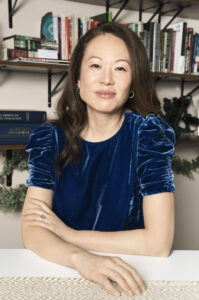
Soo Hugh: You try to map it out on script. In the writer’s room, we tried as much as we could to figure out where the thematic connections are–their emotional resonances, but it isn’t until we’re in the editing room. I always say that Pachinko is a show that’s made in the editing room. Our editors are just as nimble as our writers because they’re really writing so much of this in the edit and in the cuts, and we’re constantly moving scenes around. I always find editing to be the ultimate magic trick. All of a sudden, you move one scene, and it reads completely differently than if it did before or after a different scene. This is a show that is laborious. You just sit there, and you cut, cut, cut. One of the editors said I’ve never done this many versions of an episode ever because there are so many options.
The Contending: It makes me think of a quote that Hal Ashby said when he made Coming Home.
Soo Hugh: I love that movie.
The Contending: Me too. He shot like a million feet of film and turned it into the studio as the rough cut. And they were like, Hal, where’s the movie? Hal had been an editor. He edited In the Heat of the Night. Hal’s response was I’ll find it in the editing room, and then he did.
Soo Hugh: I’m a huge Hal Ashby fan, and that movie Coming Home was written by one of my professors at film school, Bob Jones. The last song, if you remember, as Bruce Dern is going into the water and running, is this Rolling Stones song called “Out of Time.” My homage to Coming Home was that the original title sequence song for season one was going to be “Out of Time” by the Rolling Stones. We could not afford it. It was a million-dollar song. So, as a result, The Grass Roots came and saved the day. But that movie is really close and dear to my heart.
The Contending: Fans of Pachinko wax poetic over the opening credits sequences. The joy of those sequences contrasts with the drama of the series. So, this is a two-part question: Why did you choose a counterintuitive opening, and were you worried about changing the song for season two?
Soo Hugh: I love title sequences. I come from that old-school filmmaker’s love of wanting a title sequence to tell the audience we’re about to begin, and the title sequence does that. I wanted to do something that felt like a celebration of life because so much of the show is an examination of the heartbreaks of life. It’s that balance between joy and tragedy, and we want to remind the viewers that’s what life is. I couldn’t keep the same title sequence from season one because half the actors aren’t in the show anymore, so we knew we had to redo the title sequence. My feeling is if you’re going to redo something, just go for broke. Let’s do it. And that song, The Grass Roots’ “I’d Wait a Million Years,” just felt more like season two. Season two is a story about love. Love of mothers to sons and love between a woman and a man. So it just felt more fitting.
The Contending: Sunja (Minha Kim & Youn Yuh-jung), in both timelines, is the key to the show. But the arc of this season was Noa, what happens with him, this sweet kid, dogged, learned, very bright. This secret comes out, changing his life entirely and turning it upside down. Was that how you formulated season one? Sunja is center-control, but this season is ultimately about Noa.
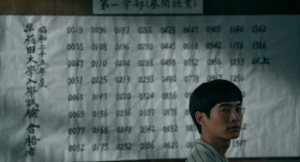
Soo Hugh: We always said that each season was going to be a handing of the baton to the next generation until the final season when the baton hands to Solomon. It all comes full circle. Noa was the ghost of season one. You heard his name and see him as a child being born, but he’s not in the present day. So, obviously, we know something happened, and season two is an answer to that.
The Contending: I’ve been fascinated by the use of pop music in the present-day sequences. When Solomon ruins the business deal in season one, he runs down the street, it starts raining, and he throws off his jacket. A cover band performs the Cure’s “Boys Don’t Cry.” That is one of my favorite sequences in any film or show I’ve ever seen.
Soo Hugh: Oh my gosh, thank you.
The Contending: I was overwhelmed by it. It’s everything I love about cinema because I don’t consider Pachinko a television show; I consider it cinema. I’m that secret Kenny Loggins fan, so when there was the Asian version of “I’m Free”—the second biggest hit Loggins had on Footloose plays…I’m just curious: how do you make these song choices for your characters?
Soo Hugh: Some of them are written into the script, in season one more so, especially the Neutral Milk Hotel song at the end, “Aeroplane Over the Sea.” That was written into the script. In season two, we did a lot more experimentation, and I have this amazing music supervisor, Michael Hill. The two of you should just get in a room together because I think you guys can wax about all the deep cuts. But we want our music to feel of a place, but at the same time of an emotional place, if that makes sense. We start off being as strict as we can, saying the music has to come from the period, and then slowly, as the show goes on, we get a lot more relaxed because we feel like we’ve earned our period stripes. I grew up on music videos. I’m a music video kid. I came home from school and watched MTV. A lot of the shows that I do, you’ll see there’s a lot of music video editing. It’s just really what I gravitate towards, that melodrama.
The Contending: Speaking of Solomon in particular, he makes this decision in season one that cuts against his business ambitions regarding his desire for ascension. And he has to start over in season two. This incredible deed that he does in season one means he has to get low again and do things that he would rather not do as a person to reestablish himself. How did you work with Jin Ha on that? He gives a wonderful performance.
Soo Hugh: I always say Jin has the hardest role on this show, by far, bar none. He has to speak three languages in our show. He has to do, within the three languages, multiple dialects. When I think about the acting muscles he has to flex on this show, and he makes it seem so seamless, it doesn’t even feel like he’s flexing, but he is flexing. Something about Jin is he is such an analytical thinker too, which I like; he’s not method. He really wants to talk about the characters–pull them apart. We passed scenes back and forth this season. I did that more this season because I’ve become close with the actors and have come to trust them. They really know their characters very well. And so Jin would give back, “Soo, I don’t get this line; this doesn’t feel right.” So I’ll take it back. There was a lot more back and forth this season.
The Contending: There’s this strange relationship between Koh Han-soo (Lee Min-ho) and Sunja (Minha) that they’re almost like magnets. They can’t get away from each other because of Noa. Every favor he does comes with strings, and Sunja sees through him, yet she’s not in a position to reject those favors. Minha does an amazing job of playing that dichotomy: I don’t really respect you, but I also know that survival is more important than respect.
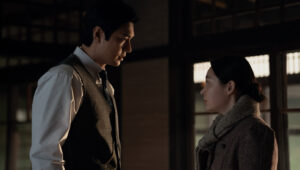
Soo Hugh: It’s complicated. You’re right. She’s always put between a rock and a hard place. And that’s just reality. One of the debates we often have in the writer’s room is who’s the villain of Pachinko. I don’t believe in villains necessarily in narratives, but if you had to drill down to who the antagonist of our show is, on the surface, you feel like it should be Han-soo, right? And then it’s the realization that the real antagonist of our show is Solomon in some ways. But Han-soo is very much the figure who you feel his manipulations over the entire plot line. The reason why episode seven in season one was so important, where you find his backstory, was that it put the stakes for him into context. I always feel like Sunja and Han-soo are either the greatest love story or the most co-dependent parenthood. Take your pick. (Laughs).
The Contending: Han-soo seems like a soul that can’t be fixed, whereas Solomon feels like a soul in progress who can still turn out to be the best version of himself.
Soo Hugh: I love what you just said. One of the reasons that’s so exciting about cross-cutting between past and present is it’s always the “what if” that hangs over our characters. What if Solomon turns out to be Han-soo? That’s why I think this structure is interesting because it’s a mystery that we’re posing within a drama.
The Contending: This is a beautiful-looking show but also a rugged-looking show. There’s that mixture of grit and bright colors. The sequence when the city they’re leaving is on fire, when you were talking firebombs, any of us in the States with any historical acumen understand Hiroshima and Nagasaki. We get that, but We don’t get the other stuff–the firebombs. I assume it was important to you to show the “other stuff.”
Soo Hugh: Yeah, and honestly, I wish I had more time and money to do it. It was so interesting to be able to show even a glimmer of what it’s like to know bombs are coming to destroy you. How do you visualize that, and how does that panic bleed onto the screen? That’s a very dark sequence when they escape from Osaka. The blacks are really heavy. If you’ve noticed, we spent a lot of time on the blacks there just to create this foreboding sense of it’s coming.
The Contending: There’s a line that I loved from this season. When the older Sunja (Youn Yuh-Jung) says, “We’re told to live a long life, but not how to pay for it.” Can you elaborate on the meaning of that line?
Soo Hugh: Everyone always says stay healthy, eat well, be good, all the aphorisms of life. But what are the realities of how you support yourself? Financial necessity is such a big part of the show. How do you live, really, like the mechanics of living? How do you put food on your table? How do you do it? One of the things that we really wanted to make sure of is that this show doesn’t feel like a fairy tale. You got old, everything’s fine. There’s still a price to pay for hard choices, even later in life. It just felt like something that was so natural out of her mouth.
The Contending: An interesting thing happened this year, and I think it is connected to Anna Sawai’s extraordinary performance on Shogun. Her part’s a little bigger this year in Pachinko–more of a turning point. She was recognized as a nominee by the Critics Choice Awards for Pachinko, and this show has been so underrecognized. Is there a little Shogun after-effect in play here?
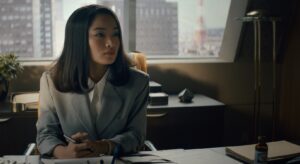
Soo Hugh: Absolutely. The second season had not come out when it was written yet, but Anna popped in season one. When we saw Anna in season one, it was very clear this was a star in the making. You get those actors once in a lifetime. I’ve been fortunate enough to get a few of them, but you know when that star is there.
The Contending: This season struck me as more somber than season one. I know season three has not been guaranteed yet, but can you talk about what direction you might be headed after season two without giving too much away?
Soo Hugh: It feels like we left on a cliffhanger, which is, what happened to Noa, right? Season three would be the period mark at the end of that sentence, where the sins of the past come back. And we need a resolution as to how this family ended up the way it is and how Solomon got to be the way he is.
The Contending: I think awards voters somehow take Pachinko for granted. It is extraordinary, and it has opened my mind and taught me so many things that I did not know. It’s also just a beautiful watch.
Soo Hugh: David, I can’t thank you enough for beating the drum. It’s a hard show to ask people to start. I always say just start the show, and we will hook you. I think people think of it as homework. It’s in another language. It’s period. It’s a history that people don’t know. The one thing I tell people that you obviously get is that this is about family. It’s about love. It’s about emotion. You’ll cry, you’ll laugh. Just watch, please, because we all filled so much of our hearts into it.
Pachinko seasons one and two are available to stream now on Apple TV+



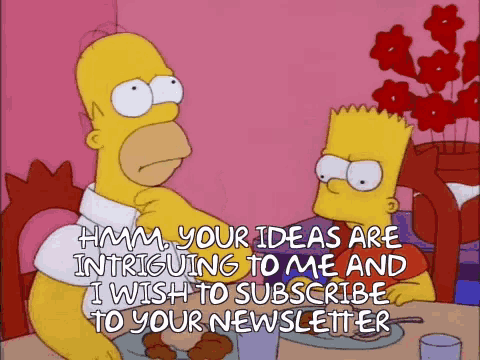
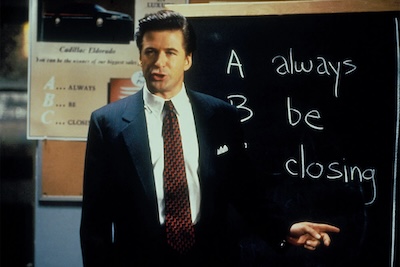
![‘Pirates! The Penzance Musical’ Breakout Star Nicholas Barasch Discusses Performing On The Tonys With Seven Stitches On His Face [VIDEO]](https://thecontending.com/wp-content/uploads/2025/06/Pirates0011r-120x86.jpg)




My favourite show of all time.
I was the same, how on earth could they even match s1? Well, they worked their magic and surpassed it!
I’ll always have favourite moments in s1 – I love young Sunja’s relationship with her dad and learning Hansu’s back story stopped him from becoming the pantomime villain. This paid off hugely in S2, and wow! The acting went up several levels too.
Praying we get S3 so that this masterpiece becomes complete.